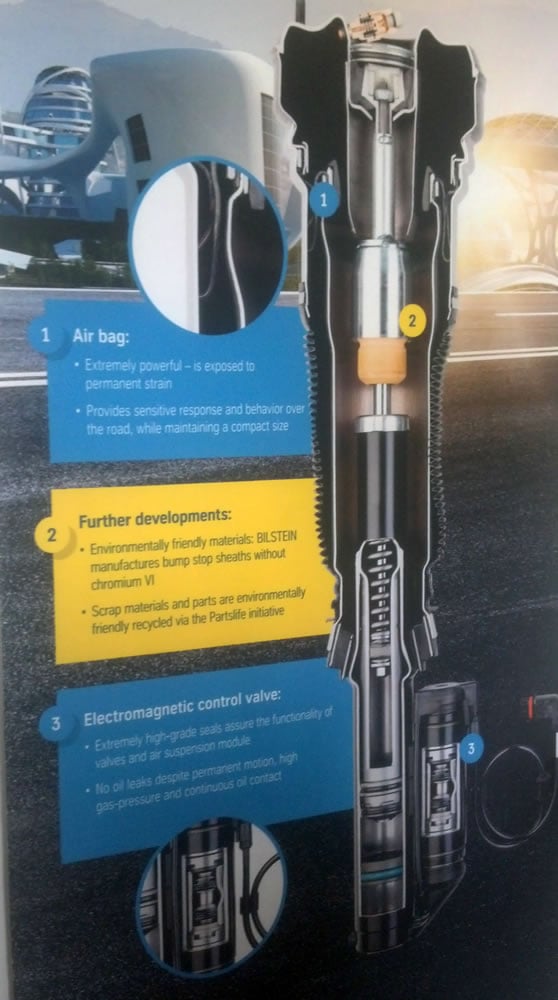Air Suspension and Replacement Dampers for Air-Ride

Dampers for Air Suspension
Air Suspension is primarily used on large commercial vehicles to provide a consistent ride quality over widely varying loads. Instead of the spring each wheel is suspended by a bellows, which is inflated by a compressor. This may be driven by an auxiliary motor, or by the vehicle's engine.
In 1950, Air Lift Company patented a rubber air spring that is inserted into a car's factory coil spring. The air spring expanded into the spaces in the coil spring, keeping the factory spring from fully compressing, and the vehicle from sagging. These were even used in NASCAR at the time.
Some large SUV's will use air suspension to deliver a comfortable ride with adjustable ride height.
There are also kits available for regular production cars, predominantly to allow them an extremely low ride height when static. Car culture comes in all shapes and forms, from meetings for historic and classic vehicles, to meetings with production cars slammed to the ground with oversize wheels and stretched tyres.
As a business the only air suspension we sell is Bilstein OEM replacement quality units. These are designed to work specifically with the manufacturers control systems which ensure the ride height will remain at a safe level both statically and dynamically. In addition manufacturer systems will usually have electronically adjustable damping.
Picture of Bilstein OEM Air system - note the air spring and damper built into one unit with electronic control of damping and air pressure.

We do not cater for the many aftermarket systems available, but recently are seeing a number of enquiries for replacement dampers for aftermarket air kits. By and large this is to replace dampers that have leaked their oil and gas. Without further information it's difficult to explain whether this is just due to running out of travel. As you can imagine as an air spring Pressure reduces, so does the spring rate. A softer spring requires more compression damping, and less rebound damping. Conversely as the spring pressure increases you need a damper with less compression damping and more rebound.
It is highly likely that the dampers are failing on these kits because the car is being driven at too low a ride height. The damper is running out travel, and if the bump stop is still fitted, is unable to control the excess energy generated by some dynamic event, e.g a pothole.
Picture of a leaking damper from an aftermarket air system - no adjustment for damping and running at a low ride height can cause this loss of oil and gas

Adjustable ride height is widely lauded as a benefit on air suspension, unfortunately as the ride height goes up and down, fairly significant changes of steering geometry occur. A manufacturer fitting air suspension as original equipment, will usually have an electronically adjustable damper to suit the changes in spring rate, and also ensure the ride height change is kept within a defined range to minimise the changes of geometry.
It seems the majority of aftermarket kits do not consider this. When Sir Alex Issigonis developed the Mini, the problem of having a lightweight car that can carry four large people, meant that regular springs would cause too much change in ride height, when fully loaded. This was solved by Alex Moulton who used rubber cone suspension which offered a rising rate under load. Air suspension doesn't actually solve the Mini problem anywhere near as elegantly as the rubber does.
Other suspension systems such as Hydragas from British Leyland or Hydropneumatic from Citroen are inherently superior to both springs and shocks, air or rubber. One of the key issues then with air Suspension is finding a damper to work properly with the spring.
For a production car, at the very least you need to know the range of spring rate on the air spring, from the range the car will be operated at. If the car develops a leak and the compressor fails generally speaking it should not be driven if fitted with an aftermarket kit. Doing so could damage the car, and the handling will be dangerous. Not to mention extreme tyre wear.
As well as the spring rate you'd need to then specify a damper that can still operate well at a low ride height when the rate is soft. In effect a stock OEM rated damper might be a better fit than a sports damper. As the ride height changes so do the damping requirements.
Get in touch for conventional springs and dampers...!










